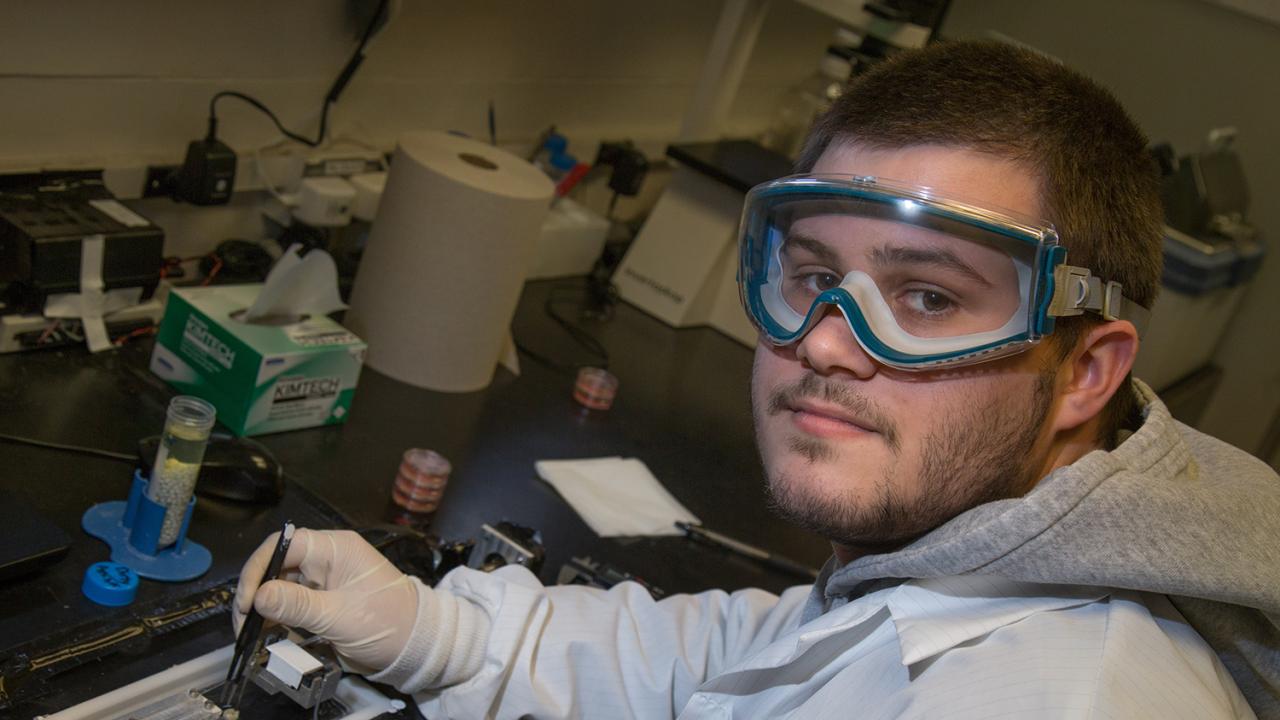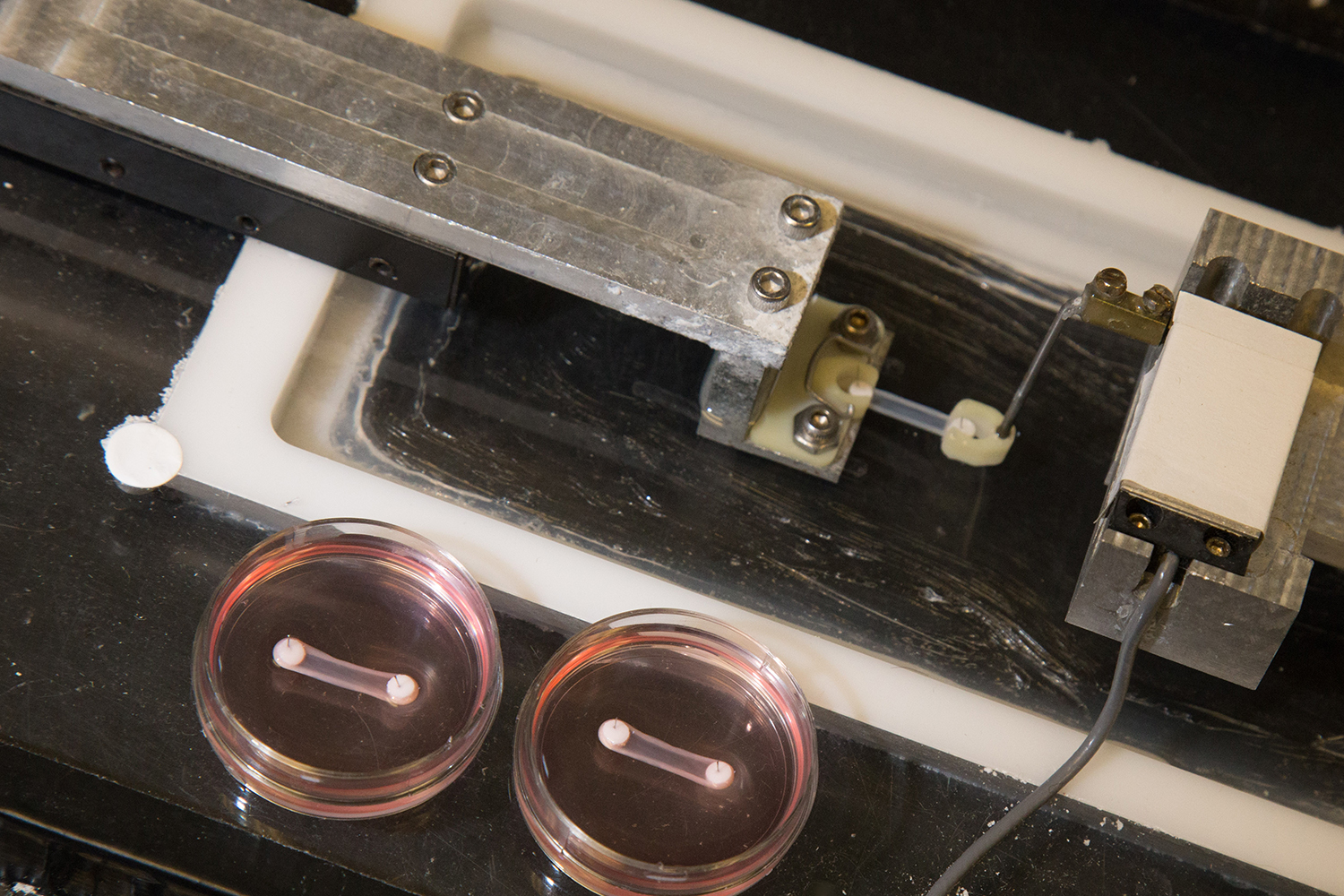
Engineering Injury Resistance, One Ligament at a Time
Neurobiology, physiology and behavior undergrad Alec Avey’s passion for sports was kindled at an early age. An outside linebacker on his high school’s football team, he took hits on the pitch and suffered his share of injuries. Nothing was more serious than a torn rotator cuff.
Now, as an undergraduate researcher in Professor Keith Baar’s Functional Molecular Biology Lab, Avey examines and modifies ligaments in Petri dishes in hopes of finding new therapeutics to aid ligament recovery.
“Tendon/ligament injuries are one of the most common and debilitating injuries people suffer,” said Baar, who holds appointments in the Department of Neurobiology, Physiology and Behavior and the School of Medicine. “By the age of 80, more than 80 percent of us will suffer a tendon or ligament rupture that decreases our quality of life.”
Avey focuses on tendonitis, recreating the condition in engineered ligaments in the lab and treating them with a myriad of natural compounds. By finding natural compounds that mitigate inflammation associated with tendonitis, scientists may reduce the need for surgeries and pricey medications by replacing or enhancing such therapies with dietary supplements.
“If we can help recovery, we will improve quality of life for millions of people,” Baar said.
Opening the doors to independent research
Avey started exploring undergraduate research opportunities at UC Davis during the spring quarter of his freshman year. While researching the labs of several professors on campus, he came across Baar’s work with engineered ligaments. Avey immediately contacted him in hopes of obtaining an undergraduate research position.

“My goal for undergraduate researchers is for each of them to contribute enough so that they become an author on a paper,” Baar said. “In order to achieve this aim, the students need to be invested.”
Avey joined Baar’s lab the summer following his freshman year. By the start of his sophomore year, he’d started work on his own projects.
“Undergrads aren’t just here to wash dishes or do some assays for grad students,” Avey said, noting his positive experience in Baar’s lab. “We’re actually learning how to do research and learning how to understand research.”
Recreating a ligament injury
In the lab, Avey can be found huddled over the workbench. In less than four weeks, he can engineer a ligament from a plate of human ACL cells. According to Baar, the lab can engineer more than 600 ligaments from the cells taken from a single human ACL. Next, Avey treats the ligament with potentially beneficial natural compounds.

To recreate tendonitis conditions in his engineered ligaments, Avey uses a signaling protein known as tumor necrosis factor-alpha, which sets off a cascade of inflammatory events mimicking tendonitis and decreasing the ligament’s mechanical function. Afterwards, he adds a natural compound like epicatechin, a flavonol found in dark chocolate that is thought to inhibit the effects of TNF-alpha, to the growth medium.
“The medium the ligament is stored in essentially represents blood,” Avey said. “It’s supposed to represent how your tissue is getting nutrients cycled through it in the body.”
He then tests the ligament’s tensile strength, attaching it to a machine that stretches the opaque tissue. Computers record and relay ligament data to Avey in graphs.
“What we want is for it to take more force to rupture the ligament,” said Baar. “Weak ligaments stretch a long way. Strong ligaments are stiff and take more load to rupture.”
While Avey has observed some positive strengthening effects in treating ligament inflammation with epicatechin, more research is needed.
Experiential learning
The Baar Lab experiments with a variety of natural compounds. They start with natural compounds previously described in scientific literature to have beneficial effects on ligaments.

For Avey, it’s all been a learning experience. When he first joined the lab, he was floored by all the information, the numerous names of proteins and pathways in the human body. Now, he’s come into his own as a scientist.
“Alec is a rare researcher,” Baar said. “He has grown in his three years in the lab to the point where he is now leading our ligament research. He has recently co-authored a book chapter and will have his first, first-authored research paper published before the end of the year.”
Media Resources
- Learn more about Baar’s research
